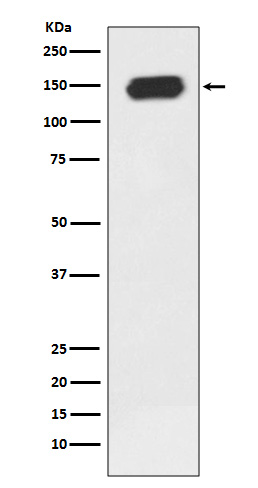
| WB | 咨询技术 | Human,Mouse,Rat |
| IF | 1/20 | Human,Mouse,Rat |
| IHC | 咨询技术 | Human,Mouse,Rat |
| ICC | 1/50-1/200 | Human,Mouse,Rat |
| FCM | 咨询技术 | Human,Mouse,Rat |
| Elisa | 咨询技术 | Human,Mouse,Rat |
| Aliases | PLCG1; PLC1; 1-phosphatidylinositol 4; 5-bisphosphate phosphodiesterase gamma-1; PLC-148; Phosphoinositide phospholipase C-gamma-1; Phospholipase C-II; PLC-II; Phospholipase C-gamma-1; PLC-gamma-1 |
| Entrez GeneID | 5335 |
| WB Predicted band size | Calculated MW: 149 kDa; Observed MW: 149 kDa |
| Host/Isotype | Rabbit IgG |
| Antibody Type | Primary antibody |
| Storage | Store at 4°C short term. Aliquot and store at -20°C long term. Avoid freeze/thaw cycles. |
| Species Reactivity | Human,Mouse,Rat |
| Immunogen | A synthesized peptide derived from human PLCG1 |
| Formulation | Purified antibody in PBS with 0.05% sodium azide. |
+ +
以下是关于PLCG1抗体的3篇参考文献示例(注:文献信息为示例性概括,具体内容请根据实际研究补充):
1. **文献名称**:*PLCG1 regulates myeloid cell proliferation in acute myeloid leukemia*
**作者**:Smith A, et al.
**摘要**:本研究通过Western blot和流式细胞术分析,使用PLCG1特异性抗体证实PLCG1在AML患者骨髓细胞中高表达,并揭示其通过PI3K/AKT通路促进白血病细胞增殖的机制。
2. **文献名称**:*PLCG1 mutations disrupt B cell signaling and cause immunodeficiency*
**作者**:Jones B, et al.
**摘要**:文章通过免疫荧光和免疫沉淀(IP)结合PLCG1抗体,发现PLCG1基因突变导致B细胞受体信号传导缺陷,进而引发患者免疫缺陷表型。
3. **文献名称**:*PLCG1 expression correlates with tumor progression in colorectal cancer*
**作者**:Wang C, et al.
**摘要**:利用PLCG1抗体进行免疫组化分析,发现结直肠癌组织中PLCG1蛋白表达水平与肿瘤分期和转移显著相关,提示其作为潜在预后标志物的价值。
如需具体文献,建议通过PubMed或Google Scholar以“PLCG1 antibody”、“PLCG1 signaling”等关键词检索近年研究。
PLCG1 (Phospholipase C Gamma 1) is a critical enzyme in intracellular signaling, primarily involved in mediating cellular responses to growth factors, hormones, and other extracellular stimuli. It catalyzes the hydrolysis of phosphatidylinositol 4.5-bisphosphate (PIP2) into inositol 1.4.5-trisphosphate (IP3) and diacylglycerol (DAG), secondary messengers that regulate calcium release and protein kinase C activation, respectively. PLCG1 is activated through tyrosine phosphorylation by receptors such as EGFR, PDGFR, and immune cell receptors, linking extracellular signals to downstream pathways controlling proliferation, differentiation, and motility.
PLCG1 antibodies are essential tools for studying its expression, activation, and localization in various contexts, including cancer, immunology, and neurological disorders. Dysregulation of PLCG1 is implicated in malignancies (e.g., breast cancer, glioblastoma), immune dysfunctions, and neurodegenerative diseases. Researchers use these antibodies in techniques like Western blotting, immunohistochemistry, and flow cytometry to assess PLCG1's role in signaling cascades or its potential as a therapeutic target. Structural studies highlight its modular domains (SH2. SH3. catalytic), which mediate protein interactions and membrane association. Despite its significance, PLCG1's dual role as an oncogene or tumor suppressor remains context-dependent, necessitating precise detection methods. Antibodies targeting specific phosphorylation sites (e.g., Tyr783) help dissect activation mechanisms, aiding drug discovery and biomarker development.
×